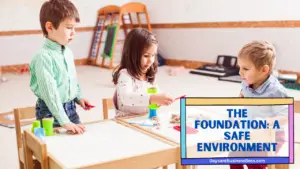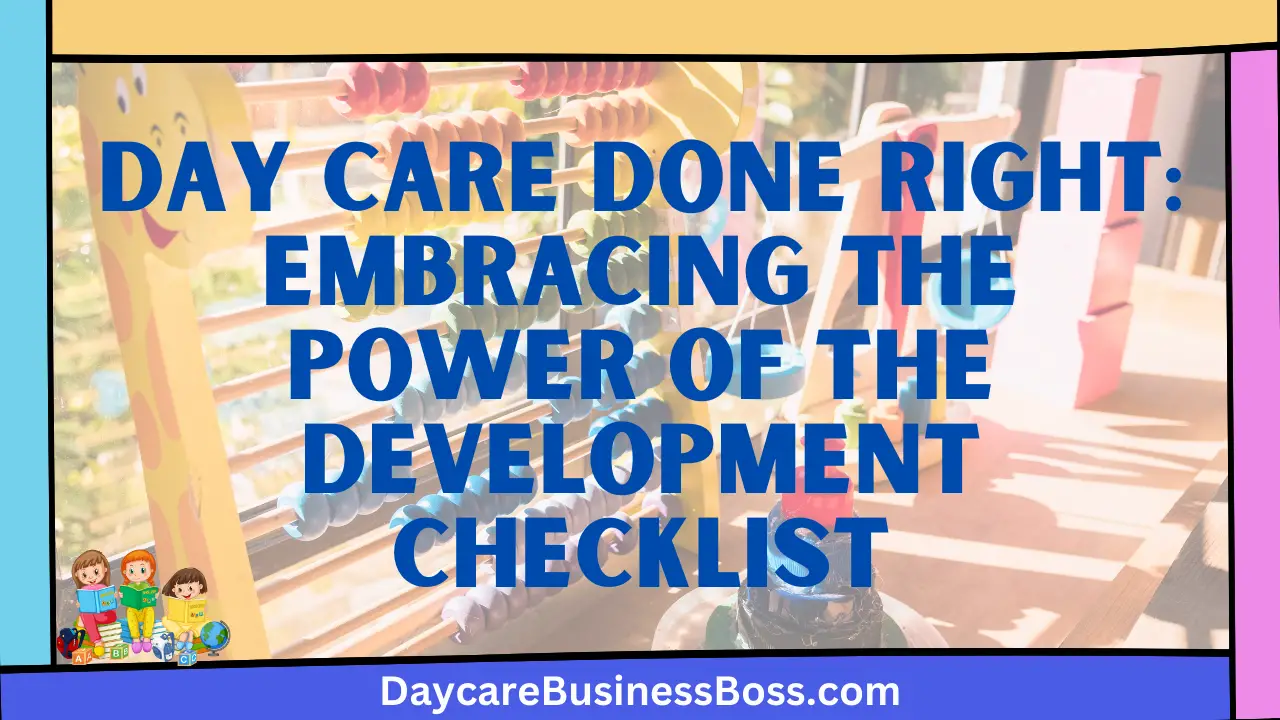Daycare centers serve an important part in nurturing young brains and promoting their progress. As these institutions serve as stepping stones for children’s first exploratory steps into the world beyond their families, maintaining their holistic development becomes a top responsibility. The concept of a “daycare development checklist” emerges as a guiding light, illuminating the route towards excellence in child care among the various obligations that daycare centers shoulder.
The most useful tool for enhancing daycare is the development checklist, which includes a safe environment, age-appropriate activities, trained staff, healthy meals, and clear communication with parents.
This article digs into the significance of the daycare development checklist, examining how it can serve as a thorough compass for daycare centers navigating the complex terrain of early childhood education. Let us begin on a journey to peel back the layers of this vital instrument that molds our youngest learners’ present and future.
The Foundation: A Safe Environment

A secure and safe atmosphere is the foundation upon which any high-quality daycare center is constructed. Parents leave their unflinching confidence in the hands of caregivers in these institutions, entrusting them with the well-being and care of their cherished children. As a result, the critical need of putting these young charges’ safety and security first cannot be emphasized.
The thorough development checklist that controls the operation of these institutions encapsulates strict attention to safety precautions. This checklist can be used to create an atmosphere that is not just favorable to early childhood development but also reduces potential dangers. A major component of this work is childproofing spaces. Daycare providers protect children from injury by recognizing potential danger zones and implementing risk-mitigation procedures. Preventive measures such as covering electrical outlets and locking cabinets storing dangerous materials lower the chance of accidents dramatically.
The dedication to maintaining age-appropriate equipment is also critical. Children’s developmental needs and physical ability change depending on their age. Daycare institutions are aware of this variation and design their facilities accordingly. Playgrounds are outfitted with age-appropriate equipment, preventing circumstances in which young children are exposed to equipment suited for older children. This not only protects the children from potential injuries but also improves their play experiences, instilling confidence and mastery in their interactions with their surroundings.
Each aspect of the facility contributes to an atmosphere that stimulates exploration, learning and play without the shadow of unwarranted hazards in creating a safe sanctuary for children. Staff have extensive training to respond effectively to situations, ensuring that they can provide immediate aid when needed. Fire evacuation drills are conducted regularly, providing children with a sense of preparation and familiarizing them with safety practices in a non-threatening manner.
Read more about: Creating a Secure Haven: Essential Safety Measures for Family Daycare Homes
Nurturing Growth with Age-Appropriate Activities
Children, with their natural curiosity and endless energy, constitute an untapped canvas. Understanding and utilizing this vitality is at the heart of good child engagement, which is centered on age-appropriate activities. The development checklist, a compass for building caring environments, focuses a particular emphasis on adapting activities to each child’s unique developmental stage.
The checklist’s approach is founded on the realization of the inherent link between engagement and growth. It emphasizes the importance of activities that not only attract young minds but also promote their cognitive, emotional, and physical development. In essence, these activities go beyond mere amusement to become significant tools for shaping well-rounded growth.
Art initiatives are one of how the checklist’s dedication is materialized. These tasks are intended not only to fill time but also to rekindle the creative fires that burn brightly within children. Playing with colors, textures, and forms encourages not only artistic expression but also fine motor skills. Painting or sculpting clay is a journey of sensory exploration that allows youngsters to interact with their world on a profound level. Art projects teach patience, attention to detail, and the satisfaction of seeing one’s imagination come to life, in addition to the aesthetic outcome.
Outdoor play activities that encourage children to interact with the world dynamically and viscerally are also important. Climbing a jungle gym, riding a tricycle, or participating in organized sports all contribute to a child’s overall development. The checklist emphasizes the necessity of exposing children to the elements, such as shifting textures underfoot and the touch of wind against their skin, all of which promote not only physical coordination but also an instinctive understanding of their surroundings. Outdoor play promotes social connections, bargaining skills, and rule awareness, laying the groundwork for well-rounded social development.
The basic goal of the development checklist is to ensure that activities correspond to the particular abilities and interests of children at each developmental stage. This personalized approach recognizes that growth is a mosaic of experiences and interactions rather than a linear process. The checklist fosters a sense of self-assurance in each kid by providing exercises that are appropriately hard but feasible.
The Heart of Quality Care: Trained Staff
Adequate staffing and ongoing professional development are two pillars that form the foundation of every highly effective daycare center. The development checklist serves as a beacon in the field of early childhood education, exposing the critical importance of well-trained professionals in creating an atmosphere that fosters and protects the development of young brains.
The checklist’s instruction is based on the acknowledgment of caregivers’ tremendous influence on the lives of children. It emphasizes the importance of educators who are well-versed in child psychology, behavior management, and first aid. These dimensions of knowledge are not mere addenda; they are the foundation upon which a safe, instructive, and nurturing environment is built. Educators that are well-versed in child psychology understand the complexities of developmental phases, ensuring that activities and interactions are tailored to the children’s changing requirements.
These caregivers’ skill set includes behavior control, a complex ballet of patience and instruction. The checklist recognizes that children may encounter hard conduct while on their journey of discovery. Trained staff, armed with approaches with built-in empathy and understanding, may navigate these waters with elegance, transforming obstacles into opportunities for development and learning.
The necessity of first aid, which is often disregarded in school settings, becomes crucial in daycare centers. Children’s excitement may result in minor mishaps or health complications. The checklist’s wisdom shines through here: instructors who are well-versed in first aid practices can respond quickly, delivering care in a way that reduces suffering and assures the child’s well-being.
The checklist’s recommendation for continual professional development demonstrates the fluid character of early childhood teaching. The world of child care is a woven tapestry of changing practices and discoveries. The checklist prevents stagnation by requiring regular training. It guarantees that the team is up to date on the most recent advancements in the sector, adopting new methods and best practices. This drive to expansion demonstrates the center’s commitment to providing the finest possible care for the children entrusted to its care.
Fueling Growth: Healthy Meals

Nutrition is a critical component in the delicate mosaic of a child’s holistic development. The development checklist emerges as a guiding light in the field of early childhood care and education, shining a light on the enormous impact that eating has on young minds and bodies. It emphasizes the critical significance of good nutrition in shaping a child’s growth trajectory.
The checklist’s recognition of nutrition’s vital role is based on a thorough grasp of the interdependence of physical and cognitive development. It emphasizes the importance of nourishing the body and mind through well-balanced and healthy meals, rather than simply supplying subsistence. The significance goes beyond just sustenance; it pervades the very fabric of a child’s potential. Nutrient-dense diets promote physical development by giving the building blocks for bones, muscles, and organs to thrive. Simultaneously, they work as cognitive function catalysts, improving memory, concentration, and learning ability.
The checklist’s instruction is based on the idea that the quality of the children’s nutrition is inextricably linked to their well-being. It promotes meal arrangements that celebrate diversity by addressing a variety of dietary limitations and preferences. Recognizing that each kid has different needs and sensitivities, these centers modify their menus to ensure that each child obtains the nutrition that is best for them. This strategy promotes inclusivity by ensuring that no child is left behind owing to dietary restrictions.
Its nutritional advocacy includes a demand to reduce the presence of highly processed meals. These highly processed foods, which are high in refined sugars, harmful fats, and chemicals, provide little nutritional benefit and frequently jeopardize long-term health. By avoiding such goods, daycare facilities connect themselves to support children’s well-being not just now, but also in the future.
The checklist’s emphasis on nutrition extends beyond the sphere of infant eating. It embraces the larger notion of establishing healthy eating habits, providing children with the tools they need to make informed nutritional decisions as they grow. Daycare facilities contribute to a future in which children are prepared with the knowledge and behaviors that promote lifetime well-being by incorporating these habits early in life.
Read more about: Creating an Enriching Childcare Environment: Insights from Childcare Consultants
Open Channels: Clear Communication with Parents
Effective communication serves as a key link between daycare centers and parents, laying the groundwork for trust and understanding. The development checklist emerges as a guiding compass within the sphere of early childhood education, emphasizing the critical role that transparent and consistent communication tactics have in maintaining this important link.
The checklist recognizes the importance of communication because it is understood that parents entrust their children to the care of these institutions. This trust is built by open and honest communication that brings parents up to date on their child’s well-being, growth, and experiences. The checklist provides parents with useful insights into their child’s day-to-day existence by advocating for regular updates on a child’s progress, daily activities, and any incidents that may have occurred. This shared knowledge gives a window into the child’s development journey, allowing parents to actively interact and encourage their child’s progress.
Transparent communication channels, as stressed by the checklist, serve as a conduit for the growth of this collaboration. Meetings, whether official or informal, provide a forum for parents to speak with caregivers and administrators about their child’s progress and any concerns they may have. Newsletters and internet platforms extend this connection beyond physical bounds, delivering snapshots of the center’s activities and developmental focus to parents. Parents are asked to immerse themselves in their child’s world by using these channels, increasing the symbiotic tie between home and daycare centers.
The basis of the checklist’s communication requirement is not only information sharing, but the development of a collaborative partnership. Daycare centers recognize the critical role that parents play as their child’s first and most enduring educators by keeping parents informed. This collaboration establishes a united support system that extends from the classroom to the home, providing an environment in which the kid feels cherished and understood.
Frequently Asked Questions

What is a daycare development checklist?
A daycare development checklist is a thorough tool that identifies key components for creating an optimal environment for children’s growth and well-being. It consists of critical elements such as a safe setting, age-appropriate activities, qualified personnel, nutritious meals, and open communication with parents. This checklist is designed to help daycare centers verify they fulfill the highest childcare standards.
How does a safe atmosphere help to improve daycare?
A safe environment is essential for high-quality daycare. Childproofing, secure equipment, and well-defined safety rules reduce risks and allow children to explore and learn without risk. Daycare centers focus on the physical and emotional safety of children by adhering to the development checklist’s emphasis on a safe environment, offering parents peace of mind and encouraging a good learning experience.
How important is clear communication with parents in daycare?
Building trust and maintaining a collaborative partnership between daycare centers and families requires open communication with parents. The checklist emphasizes the significance of providing regular updates on children’s progress, daily activities, and any events. Transparent communication channels enable parents to actively participate in their child’s daycare experience, instilling a sense of involvement and ensuring that their child’s needs are satisfied.
To learn more on how to start your own daycare checkout my startup documents here.
The information provided by DaycareBusinessBoss.com (“The Site”) is for general informational purposes only. All information on the Site is provided in good faith, however, we make no representation or warranty of any kind, express or implied, regarding the accuracy, adequacy, validity, reliability, availability or completeness of any information on the Site. Under no circumstance shall we have any liability to you for any loss or damage of any kind incurred as a result of the use of the Site or Reliance on any information provided on the Site. Your use of the Site and your reliance on any information on the Site is solely at your own risk.
This blog post is for educational purposes only and does not constitute legal advice. Please consult a legal expert to address your specific needs. Terms and Conditions. (https://daycarebusinessboss.com/terms-conditions/)

Meet Shawn Chun: Entrepreneur and Childcare Business Fan.
I’m a happy individual who happens to be an entrepreneur. I have owned several types of businesses in my life from a coffee shop to an import and export business to an online review business plus a few more and now I create online daycare business resources for those interested in starting new ventures. It’s demanding work but I love it. I do it for those passionate about their business and their goals. That’s why when I meet a childcare business owner, I see myself. I know how hard the struggle is to retain clients, find good employees and keep the business growing all while trying to stay competitive.
That’s why I created Daycare Business Boss: I want to help childcare business owners like you build a thriving business that brings you endless joy and supports your ideal lifestyle.


